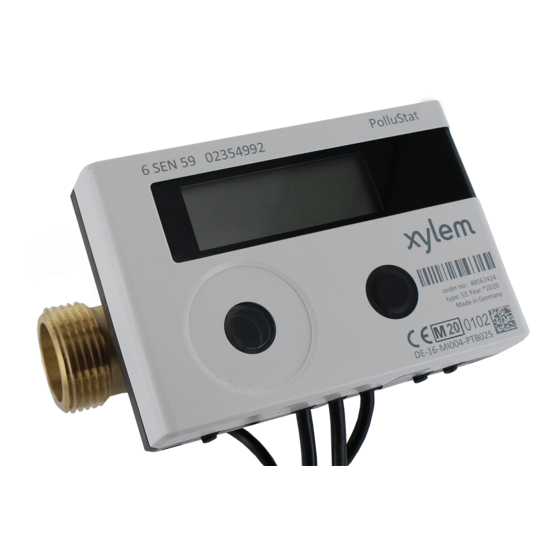
Inhaltsverzeichnis
Werbung
Verfügbare Sprachen
Verfügbare Sprachen
Quicklinks
DE FR ES IT EN
Bedienungsanleitung Kommunikationsschnittstellen / Mode d'emploi Interfaces de communication /
Manual de instrucciones Interfaces de comunicación / Manuale d'uso Interfacce di comunicazione /
Operating Instructions Communication Interfaces:
PolluStat & PolluTherm F
Übersicht Schnittstellen und Optionen /
Interfacce e optional / Overview Interfaces and Options:
1.1 Optische (Infrarot-)Schnittstelle / Interface optique (infrarouge) / Interfaz óptica / Interfaccia ottica a infrarossi / Optical
(infrared) interface
Optional / en option / opcional / opzionale / optional
1.2 M-Bus
1.3 Modbus
1.4 Kabellose Schnittstellen/ Interfaces radio sans fil/ Interfaces inalámbricas / Interfacce wireless / Wireless Interfaces
1.4.1 wireless M-Bus
1.4.2 LoRaWAN
1.5 Drei zusätzliche Impulseingänge / Trois entrées d'impulsions supplémentaires / Tres entradas de impulsos adicionales /
Ingressi impulsi aggiuntivi / Three additional pulse inputs
1.6 Ein Impulsausgang potenzialfrei / Une sortie d'impulsions sans potentiel / Una salida de impulsos de libre potential / Uscita
impulsi a potenziale libero / One potential-free pulse output
1.7 Zwei Impulsausgänge potenzialfrei / Deux sorties d'impulsions sans potentiel / Dos salidas de impulsos de libre de
potencial / Uscite impulsi a potenziale libero / Two potential-free pulse outputs
Page 1 of 58
1080619050 / MH 4310 INT5
Aperçu
Interfaces et options / Resumen Interfaces y opciones / Panoramica
2021_07_05
V 0001
Technische Änderungen und Irrtümer vorbehalten.
Werbung
Inhaltsverzeichnis

Inhaltszusammenfassung für Xylem Sensus PolluStat
- Seite 1 DE FR ES IT EN Bedienungsanleitung Kommunikationsschnittstellen / Mode d'emploi Interfaces de communication / Manual de instrucciones Interfaces de comunicación / Manuale d’uso Interfacce di comunicazione / Operating Instructions Communication Interfaces: PolluStat & PolluTherm F Übersicht Schnittstellen und Optionen / Aperçu Interfaces et options / Resumen Interfaces y opciones / Panoramica Interfacce e optional / Overview Interfaces and Options:...
-
Seite 2: Zusätzliche Technische Spezifikationen
Bedienungsanleitung Kommunikationsschnittstellen PolluStat & PolluTherm F 1 Schnittstellen und Optionen 1.1 Optische (Infrarot-)Schnittstelle Zur Kommunikation mit der optischen Schnittstelle ist ein optischer Auslesekopf nötig. Der Auslesekopf und eine geeignete Konfigurations-Software sind optional erhältlich. Die optische (Infrarot-)Schnittstelle wird durch das automatische Senden eines Vorspanns (nach EN 13757-3) aktiviert. Baudrate: 2.400 Bd. - Seite 3 1.2.3 Technische Daten M-Bus Primäradresse 0 (Werkseinstellung); 1 - 250 (konfigurierbar) Baudrate 2400; 300 Länge Anschlussleitung Anzahl der möglichen Auslesungen unbegrenzt Aktualisierungsrate der Daten 120 s; bei Verwendung des Netzteils 2 s 1.3 Modbus RTU (optional) Das Modbus RTU Modul ist eine galvanisch getrennte Schnittstelle zur Übertragung von Zählerdaten (Absolutwerte). Das Modul ist für die Verwendung mit PolluStat-Wärmezählern und PolluTherm F-Rechnern ausgelegt, um sie über den EIA-485-Kanal mit dem Modbus RTU-Netzwerk zu verbinden.
-
Seite 4: Aktivierung Der Funk-Schnittstelle
1.4.1.1 Technische Daten Funk Betriebsfrequenz 868 MHz Sendeleistung bis zu 14 dBm Protokoll wireless M-Bus in Anlehnung an die EN 13757-3, -4 Wahlweise Betriebsart S1 / T1 / C1 Telegramme kurzes Telegramm konform für AMR (OMS- langes Telegramm für Walk-by-Auslesung: Spec_Vol2_Primary_v301 und _v402): Energie (Wärme-/Kälteenergie, o Energie (Wärme-/Kälteenergie,... -
Seite 5: Technische Daten
1.4.1.4 Nachträgliche Aktivierung der Funk-Verschlüsselung Die AES-Verschlüsselung kann auch nachträglich aktiviert werden. Dies kann auf zwei Arten geschehen: a) Die Verschlüsselung kann mit dem Taster aktiviert werden. Mit langem Tastendruck bis in die Anzeigenschleife „6“ (Modulschleife) umschalten. Dann mit kurzem Tastendruck zur 3ten Anzeige „AES off“ schalten (s. Bild). Um den Editiermodus zu starten, müssen Sie anschließend die Taste noch einmal für 2-3 Sekunden drücken. -
Seite 6: Drei Zusätzliche Impulseingänge (Optional; Nur In Verbindung Mit M-Bus Oder Funk)
Pulse input selection Auswahlmöglichkeit zwischen 0-3 Impulseingängen * Das tatsächliche Sendeintervall ist abhängig von der Telegrammart sowie der aktuellen Datenrate. Das Sendeintervall wird entsprechend angepasst, um die eingestellte Batterielebensdauer (EcoMode 10 bzw. 6 Jahre) zu gewährleisten. Nähere Informationen finden Sie im „Manual LoRa Module“. ** Für Impulseingang muss Typ Sensus ausgewählt werden;... -
Seite 7: Technische Daten Impulseingänge
1.5.2 Technische Daten Impulseingänge Klasse Impulseingänge IB nach EN 1434-2:2016 Länge Anschlussleitung Versorgungsspannung + 3 V DC Quellenstrom = 1,5 µA Schaltschwelle des Eingangssignals bei U ≥ 2 V High-Level Schaltschwelle des Eingangssignals bei U ≤ 0,5 V Low-Level Endwiderstand 2 MΩ... -
Seite 8: Ein Impulsausgang Potenzialfrei (Optional)
Braun IE3+ Weiß IE3┴ 1.6 Ein Impulsausgang potenzialfrei (optional) Über den Impulsausgang potenzialfrei werden Zählimpulse des Zählers ausgegeben. Der Impulsausgang schließt entsprechend der Impulswertigkeit, siehe die Anzeige „Impulswertigkeit Impulsausgang 1“ in Anzeigenschleife „6“ (Modulschleife). Nach dem Einstecken des Moduls erkennt der Zähler Nenngröße und Energieanzeige und stellt damit die Impulswertigkeiten für Energie und Volumen selbstständig ein entsprechend den nachfolgenden Hinweisen. -
Seite 9: Zwei Impulsausgänge Potenzialfrei (Optional)
1.7 Zwei Impulsausgänge potenzialfrei (optional) Über die zwei Impulsausgänge potenzialfrei werden Zählimpulse des Zählers ausgegeben. Die Impulsausgänge schließen entsprechend der Impulswertigkeit, siehe die Anzeigen „Impulswertigkeit Impulsausgang 1“ und „Impulswertigkeit Impulsausgang 2“ in Anzeigenschleife „6“ (Modulschleife). Wärmezähler Kältezähler Wärme- / Kältezähler Impulsausgang 1 Wärmeenergie Kälteenergie... - Seite 10 Danach den Schraubendreher in einem Winkel von ca. 45° in eine der beiden Öffnungen einführen und vorsichtig nach oben bewegen bis zu einem Winkel von ca. 90° (siehe Bild 2). Die Oberschale des Rechenwerks ist nun auf dieser Seite nicht mehr eingerastet.
- Seite 11 Zum Entfernen eines Moduls muss beim Aufklappen des Rechenwerks die Oberschale sorgfältig gegen die Rückwand der Unterschale gedrückt werden. Dabei hebeln die hinteren zwei Gehäuse-Verrastungen der Oberschale das Modul von der Platine los (siehe Bild 4). Page 11 of 58 1080619050 / MH 4310 INT5 Stand: 2021_07_05 V 0001 Technische Änderungen und Irrtümer vorbehalten.
- Seite 12 3 Anzeigemöglichkeiten in der Modulschleife (optional) Ebene 6 / Modulschleife: oder: oder: 3) Anzeige je nach 1) Anzeige des gesteckten 2) Anzeige je nach gestecktem Modul und gestecktem Modul und Moduls (alternativ): Einstellung: Einstellung: 5 = 1 Impulsausgang; wireless M-Bus wireless M-Bus (radio) off/ 8 = Funk mit optional 3 Verschlüsselung (AES) off/...












